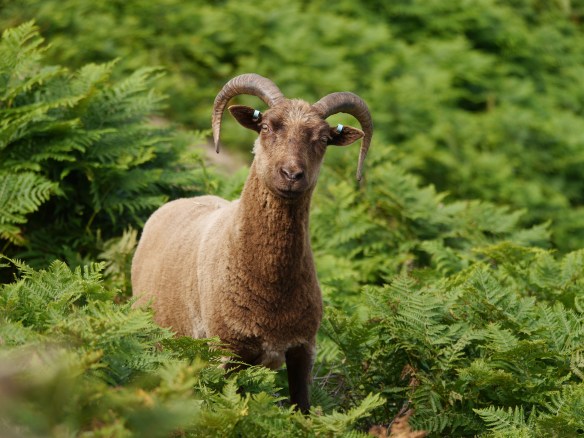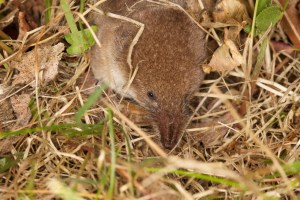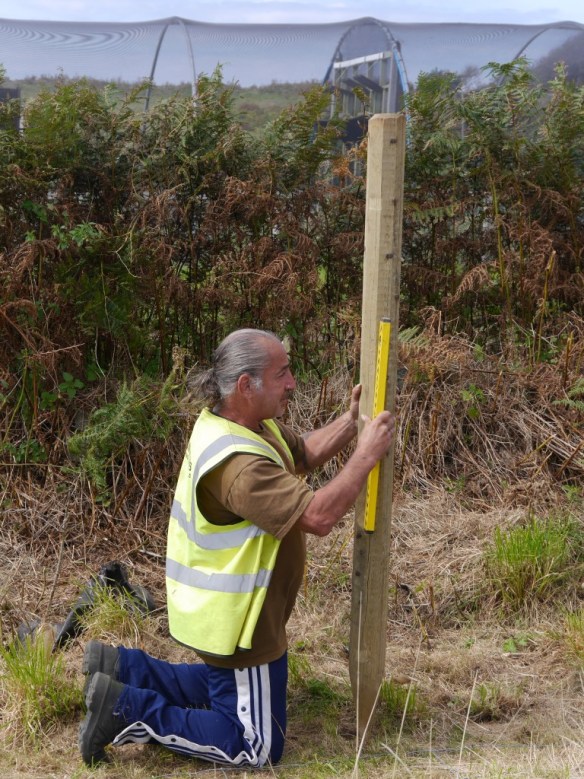Jersey’s free-living chough population now stands (and flies) at twenty-two individuals since the release of the captive-reared chicks in September. So how have they been coping with life on the north coast?
The seven young captive-bred choughs have integrated well into the free-living flock. Social ‘pecking order’ was established relatively quickly with most of the bickering being between the juveniles and restricted to feed times at the aviary.
It also tends to be the boys more than the girls who squabble. Brothers Kevin and Lee always bicker at feeds, but spend the rest of the time preening each other. A true ‘bromance’?
They are quite competent at searching for wild insects. Bills buried deep in soil and sheep muck. Kevin and Lee even turned their attention to a fresh mole hill, pretty much levelling it in their quest for food.
As the cold, wet winter weather sets in the abundance of insects living in the soil decreases, which means the choughs’ wild food supply becomes limited. Like their neighbours in the UK they look for alternative food sources at this time of year to top up their calories.
 Last winter the group showed a great deal of interest in the hawthorn berries around the aviary. This year was no different and the new chicks joined in with the foraging.
Last winter the group showed a great deal of interest in the hawthorn berries around the aviary. This year was no different and the new chicks joined in with the foraging.

Choughs use the hawthorn trees around the aviary site as a vantage point to rest and preen as well as a food source in the autumnal months. Photo by Liz Corry.
Our flock have the benefit of sympathetic staff who can interpret their insistent chatter and stalking from above as “please can we have some more food in our bowls?”
After a busy day of hunting for insects the new choughs go to roost in the aviary along with the other juveniles. Prior to their release in September there were seven choughs roosting in the quarry, Dusty had left his parents and joined the aviary roost group.
This appeared to stay the same after the release.
However, when the clocks changed on 25th October field-staff made a new discovery: A clear sky and a bright, almost full, moon provided enough light for the choughs to carry on foraging near the aviary once the sun had set.
To be fair, their internal clocks may have been slightly skewed (with ours) making them think they had at least another hour before bed.
Suddenly the birds took to the air and headed straight for the aviary. At least one pair broke away and shot off to the quarry. Two others disappeared from view.
Had they sneaked into the aviary via the other side? Had they left for the quarry, but been missed in the melee of choughs flying around the aviary? All we knew was at least 18 roosted at the aviary; four more than normal.
We repeated our roost checks and also checked in with Ronez Quarry to see what information they could provide. We now know that White and Mauve still roost in the quarry. The remaining adults, Green, Blue (Mrs Green), Black, Red, and her young man Dingle, all roost at the aviary.
There have also been changes in where the choughs hang out during the day. Breakfast time is spent over at Devil’s Hole no longer near the heather regeneration area on the east side of Mourier Valley.
We knew of their visit to Les Landes last month thanks to public sightings. This month we have had several sightings of choughs flying around le Câtel Fort, Grève de Lecq, which is halfway between Les Landes and Sorel (as the chough flies). Many thanks to Keith Pyman for those reports. He was lucky enough to see them pretty much once a week throughout October flying over his house. We cannot physically get there in time to know where they go after that. Are they passing Grève de Lecq on the way to Les Landes? Are they just scoping out the cliffs at Petit Grève? All we know is that they are back at Sorel in time for their lunch feed acting all nonchalant.
Not every chough made the journey beyond Devil’s Hole in October. Sometimes it is just four birds, at other times it is a group of seven or fourteen. We cannot be sure which individuals travel without being there to see their leg rings. Even then it requires them to be on the ground not flying with their feet tucked in. The radio-tracked group of seven tend to favour staying at Mourier Valley. Again not having transmitters attached to the other 15 doesn’t help our chances of being able to identify those who wander off.
One thing we can be certain on is the health of our choughs. Our close daily monitoring allows us to know when something is wrong. When that something is Dusty, Jersey’s wild-born chick, our own stress levels tend to increase let alone the bird’s.
A fortnight into Nicola Cox starting her six-month student placement on the project she spotted Dusty occasionally open-mouthed breathing. This could be due to several different reasons most of which are mundane and fleeting.
We continued to monitor him closely and could see that his breathing was gradually becoming laboured and he started sneezing. We know this usually means one thing and a faecal sample from Dusty confirmed it. He had Syngamus, a gapeworm, and in quite high numbers. Thankfully this is very treatable, but it did mean we had to catch him up to worm him.
The easiest, least stressful way of doing this was to call all twenty-two choughs back to the aviary just before roost and lock them in. I held off giving them their afternoon feed until then to ensure they were all motivated enough to stay inside the aviary eating. First thing the following morning we went in and caught Dusty in hand-nets. Within minutes Dusty had been checked over by the Vet, given medication, and the whole group given access back outside. The choughs appeared unfazed and within a couple of days he had stopped sneezing and breathing normally. Quite an exciting and thankfully positive end to the month.





















 By Liz Corry
By Liz Corry








































